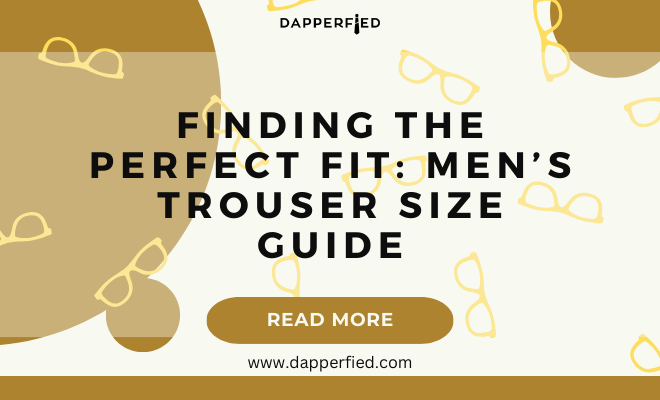
Men's Style
Finding the Perfect Fit: Men’s Trouser Size Guide
When it comes to men’s trouser sizing, it can often be confusing and overwhelming to find the perfect fit. Understanding the basics of trouser sizing is essential to ensure that you find the right pair of trousers that not only look great but also feel comfortable. Men’s trouser sizing typically includes measurements for the waist, hips, inseam, and sometimes even the rise and leg opening. These measurements are crucial in determining the right fit for your body type and personal style. It’s important to note that different brands may have slightly different sizing standards, so it’s always best to refer to the specific brand’s sizing chart when making a purchase.
Key Takeaways
- Men’s trouser sizing can be confusing, but understanding the basics can help you find the perfect fit.
- Measuring for the perfect fit involves taking accurate waist, hip, inseam, and rise measurements.
- Different styles and fits, such as slim, straight, and relaxed, can affect how trousers look and feel on the body.
- Trouser length and inseam measurements are crucial for ensuring the trousers are the right length for your height.
- Waist and hip measurements are essential for determining the right size and fit for trousers.
- Trouser rise and leg opening measurements can impact the overall comfort and style of the trousers.
- Trouser size conversion charts can help you find the right size when shopping internationally or across different brands.
Measuring for the Perfect Fit
Measuring for the perfect fit is the first step in finding the right pair of trousers. To measure your waist, use a flexible tape measure and wrap it around your natural waistline, which is typically located just above the belly button. Make sure the tape measure is snug but not too tight. For the hip measurement, wrap the tape measure around the fullest part of your hips, ensuring that it’s parallel to the floor. The inseam measurement is taken from the crotch to the bottom of the leg, where you want the trousers to end. It’s important to stand up straight and have someone else take this measurement for accuracy. Additionally, some brands may also provide measurements for the rise, which is the distance from the crotch seam to the top of the waistband, and the leg opening, which is the circumference of the bottom of the trouser leg. Taking accurate measurements is crucial in finding trousers that fit well and look flattering on your body.
Different Styles and Fits
Men’s trousers come in a variety of styles and fits, each designed to cater to different body types and fashion preferences. Some common styles include straight-leg, slim-fit, skinny, bootcut, and relaxed fit. Straight-leg trousers have a consistent width from the thigh to the hem, providing a classic and timeless look. Slim-fit trousers are more tailored and have a narrower leg opening, creating a sleek and modern silhouette. Skinny trousers are even more fitted than slim-fit trousers, with a very narrow leg opening for a trendy and fashion-forward look. Bootcut trousers have a wider leg opening to accommodate boots and provide a more relaxed fit through the thigh. Relaxed fit trousers offer a looser fit throughout the leg for maximum comfort. Understanding the different styles and fits can help you choose trousers that not only complement your body type but also align with your personal style.
Trouser Length and Inseam
| Trouser Size | Length (inches) | Inseam (inches) |
|---|---|---|
| Small | 40 | 30 |
| Medium | 42 | 32 |
| Large | 44 | 34 |
The length of men’s trousers is an important factor in achieving a polished and put-together look. The inseam measurement plays a crucial role in determining the proper length of trousers. The inseam measurement is taken from the crotch to the bottom of the leg, where you want the trousers to end. The ideal trouser length will depend on personal preference and the style of trousers being worn. For a classic and timeless look, trousers should have a slight break at the front, where they rest on top of the shoe with a small fold or crease. This creates a clean and polished appearance while also preventing the trousers from dragging on the ground. However, some modern styles may call for a shorter length with little to no break, creating a more contemporary and fashion-forward look. Ultimately, finding the right trouser length is essential in achieving a well-proportioned and stylish appearance.
Waist and Hip Measurements
The waist and hip measurements are key components in finding trousers that fit comfortably and flatteringly. The waist measurement is taken around the natural waistline, which is typically located just above the belly button. It’s important to ensure that the waistband of the trousers sits comfortably at this point without being too tight or too loose. The hip measurement is taken around the fullest part of the hips, ensuring that the tape measure is parallel to the floor for an accurate measurement. This measurement is crucial in determining how the trousers will fit around the hips and thighs, ensuring that they are neither too tight nor too loose. Finding the right balance between waist and hip measurements is essential in achieving a comfortable and flattering fit that looks great on any body type.
Trouser Rise and Leg Opening

The rise and leg opening measurements are often overlooked but play a significant role in determining how trousers will fit and look on the body. The rise measurement refers to the distance from the crotch seam to the top of the waistband. A proper rise measurement ensures that trousers sit comfortably at the natural waistline without being too low or too high. This measurement is crucial in achieving a comfortable fit that doesn’t feel constricting or uncomfortable around the crotch area. The leg opening measurement refers to the circumference of the bottom of the trouser leg. This measurement determines how wide or narrow the leg opening will be, which can significantly impact how trousers look on the body. Understanding these measurements can help you find trousers that not only fit well but also look stylish and flattering.
Trouser Size Conversion Charts
When shopping for men’s trousers internationally or from different brands, it’s important to refer to trouser size conversion charts to ensure that you find the right fit. Different countries and brands may have varying sizing standards, making it essential to refer to conversion charts for accurate sizing information. These charts typically provide conversions between different sizing systems, such as US, UK, EU, and international sizes, allowing you to easily find your corresponding size in different regions or brands. Additionally, some conversion charts may also include measurements in inches or centimeters for further clarity. By referring to trouser size conversion charts, you can confidently shop for trousers from different brands and regions without worrying about finding the right size.
In conclusion, understanding men’s trouser sizing is essential in finding trousers that not only fit well but also look stylish and flattering on any body type. By taking accurate measurements for waist, hips, inseam, rise, and leg opening, you can ensure that you find trousers that fit comfortably and complement your personal style. Additionally, understanding different styles and fits, as well as referring to trouser size conversion charts when shopping internationally or from different brands, can further enhance your ability to find the perfect pair of trousers. With these insights into men’s trouser sizing, you can confidently shop for trousers that not only look great but also feel comfortable and stylish.
If you’re looking for the perfect pair of trousers, you might also be interested in upgrading your underwear game. Check out this article on men’s fashion underwear to find out how to choose the best underwear for your body type and style. Understanding how to dress from the inside out is just as important as finding the right pair of trousers.
FAQs
What is the importance of knowing your trouser size?
Knowing your trouser size is important because it ensures that you are comfortable and confident in the clothes you wear. Ill-fitting trousers can be uncomfortable and may not look as flattering as trousers that fit properly.
How do I measure my trouser size?
To measure your trouser size, use a tape measure to measure around your waist at the narrowest part, and around your hips at the widest part. You can also measure the inseam by measuring from the crotch to the bottom of the leg.
What are the different trouser size measurements?
Trousers are typically sized based on waist and inseam measurements. The waist measurement is the circumference of the waist, and the inseam measurement is the length from the crotch to the bottom of the leg.

What if my waist and inseam measurements fall between sizes?
If your waist and inseam measurements fall between sizes, it is recommended to go with the larger size and have the trousers tailored to fit properly.
Are trouser sizes consistent across all brands?
No, trouser sizes can vary between different brands and even different styles within the same brand. It is important to refer to the specific brand’s size guide for accurate measurements.
What are some common trouser size variations for men?
Common trouser size variations for men include slim fit, regular fit, and relaxed fit. These variations refer to the overall fit and silhouette of the trousers.













